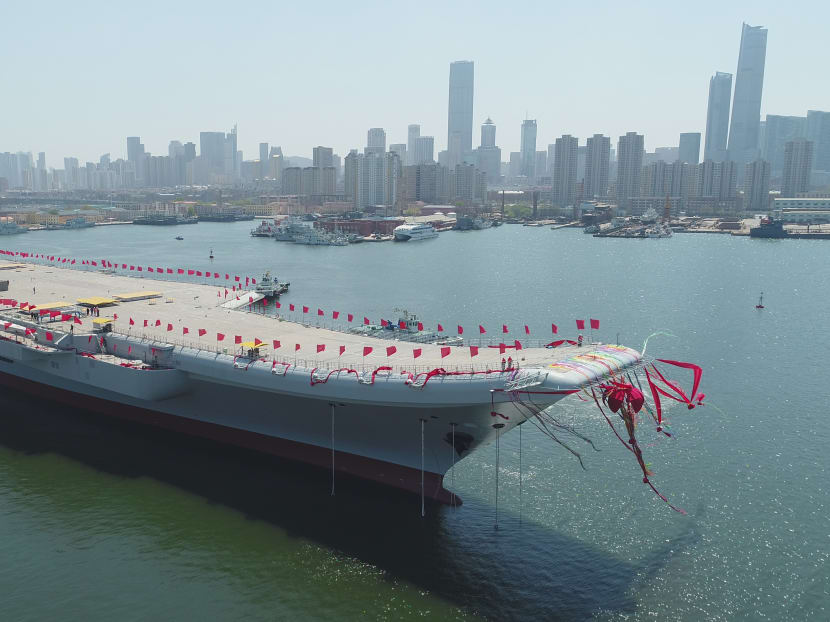China towers over Asian navies with new carrier launch
BEIJING — China has launched its first indigenously built aircraft carrier, in a demonstration of the growing sophistication of its defence industries and Beijing’s intention to become the unrivalled naval power among Asian nations.

In this photo released by China's Xinhua News Agency, a newly-built aircraft carrier is transferred from dry dock into the water at a launch ceremony at a shipyard in Dalian in northeastern China's Liaoning Province, Wednesday, April 26, 2017. Photo: Xinhua via AP
BEIJING — China has launched its first indigenously built aircraft carrier, in a demonstration of the growing sophistication of its defence industries and Beijing’s intention to become the unrivalled naval power among Asian nations.
The 70,000-tonne carrier was towed from its dockyard just after 9am yesterday following a ceremony in the northern port city of Dalian, where its predecessor, the Soviet-built Liaoning, also underwent extensive refurbishing before being commissioned in 2012, the Ministry of National Defence said.
The launch “shows our country’s indigenous aircraft carrier design and construction has achieved major step-by-step results”, Xinhua news agency said.
State television showed the carrier, its deck lined with red flags, being pushed by tug boats into its berth.
Mr Fan Changlong, a vice-chairman of China’s powerful Central Military Commission, presided over the ceremony, Xinhua said, during which a bottle of champagne was broken on the bow.
The vessel is temporarily named the Type 001A, though previous reports have said it would probably be called the Shandong, after the eastern Chinese province. The platform is expected to be operational sometime before 2020, after sea trials and the arrival of its full air complement.
Like the 60,000-tonne Liaoning — China’s sole operational carrier which was purchased from the Ukraine, the new carrier is based on the Soviet Kuznetsov-class design. It has a ski jump-style deck for taking off and a conventional oil-fuelled steam turbine power plant.
That limits the weight of payloads its planes can carry, its speed and the amount of time it can spend at sea relative to American nuclear-powered carriers.
China is believed to be planning to build at least two and possibly as many as four additional carriers, with one of them, the Type 002, reported to be already under construction. They are expected to be closer in size and capabilities to America’s nuclear-powered 100,000-tonne Nimitz- and Ford-class ships, with flat flight decks and catapults to allow planes to launch with more ordnance and fuel aboard.
While the new Chinese vessel pales in comparison with its American counterparts, its coming into service would make China become the premier aircraft carrier power among Asian nations.
After all, none of the major regional powers own vessels that match up to China’s two carriers.
India’s carriers — the Vikramaditya currently in service and the upcoming Vikrant — weigh around 40,000 tonnes and can deploy 30 aircraft, while the largest and most capable “aviation-capable” vessel of the Japanese Maritime Self-Defence Force is the Izumo-class 27,000-tonne “helicopter destroyer” that carries less than a dozen helicopters.
Along with their role in protecting China’s maritime interests, Chinese naval strategists see the carrier programme as “about having naval power commensurate with China’s international status, to impress both external and domestic audiences”, noted China expert Michael Chase of the United States think-tank Rand Corporation.
The new carrier “is likely to be seen as further evidence of China’s desire to become the most powerful and influential country in the region,” Dr Chase said.
That will be especially worrying to Indian security analysts who are already concerned about Beijing’s ambitions in the Indian Ocean, he added.
India, along with Japan and Taiwan which also view Chinese carriers as threats, will likely respond by building new submarines and anti-ship missiles, said Mr Ian Easton, a research fellow at the US think-tank Project 2049 Institute.
China’s “expansionist behaviour in the South China Sea and its aggressive efforts to undermine the security of Taiwan and Japan, in particular, have translated into a situation where few countries now trust that Beijing has benign motives,” Mr Easton noted.
Beijing has offered little information about the roles it expects its carriers to play.
The Liaoning was initially touted mainly as an experimental and training vessel, but was declared last December to be combat-ready and has taken part in live-firing exercises in the South China Sea, where tensions have risen over China’s construction of man-made islands complete with airstrips and military structures.





